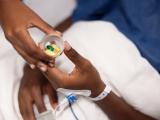Nov 25, 2009
College flu cases continue to drop
Influenza activity at US colleges continued to significantly decline last week, with all but seven states reporting decreases, the American College Health Association (ACHA) reported today. New cases dropped 37% from the previous week. The report for the week ending Nov 20 said the attack rate was 13.4 cases per 10,000 students, but with no deaths. The ACHA said pandemic vaccine uptake is low, with only 4% vaccinated just before the Thanksgiving break.
http://www.acha.org/ILI_Surveillance.cfm/?date=112509
ACHA report for week ending Nov 20
CDC advisors pressed on ventilator allocation
A conference call among advisors to the Centers for Disease Control and Prevention (CDC), held to discuss rationing of ventilators in a severe pandemic, turned contentious Monday, according to the Web site Politico.One member of the public who asked questions during the call said the strategy was "Hitlerian" and called for buying as many ventilators as would be necessary to treat potentially millions of patients, regardless of the cost. An adviser called that approach unrealistic.
http://www.politico.com/blogs/joshgerstein/1109/CDC_ventilator_rationing_panel_rejects_attack.html
Nov 23 Politico report
China, Hong Kong report virus mutation
A Chinese official said today that the country this summer detected the pandemic H1N1 virus mutation seen in Norway and other countries, China Daily reported. Feng Zijian, with the Chinese Centers for Disease Prevention and Control, said the mutated virus didn't seem to be more virulent and wasn't linked to any deaths. On Nov 23 Hong Kong officials said they detected the mutation in July in a toddler who has recovered, Xinhua reported.
http://english.people.com.cn/90001/90782/90880/6823590.html
Nov 25 China Daily story
First H1N1 wave hit 1 in 6 UK children
Serology studies by the United Kingdom's Health Protection Agency (HPA) reveal that about 15% of children in England became infected with H1N1 flu during the pandemic's first wave in spring and summer. That proportion rose in certain areas of the country, with 25% of children under 15 infected in London and the West Midlands, and 21% of those age 15 to 24. About one third of children tested in a boarding school who showed no symptoms had actually been infected, the agency said.
http://www.hpa.org.uk/web/HPAwebFile/HPAweb_C/1258560552857
Nov 24 HPA overview
Another Wales patient has resistant strain
An additional patient has tested positive for H1N1 resistant to oseltamivir (Tamiflu) at a Wales hospital, according to the National Public Health Service for Wales (NPHS). The patient, tested as part of routine screening, was linked with the other five patients whose resistant cases were uncovered last week. Test results are pending on one other direct contact of the six patients. An NPHS official said the new case "was not unexpected."
http://www.wales.nhs.uk/newsitem.cfm?contentid=13752
Nov 25 NPHS report
Officials still probing recalled vaccine lot
In the investigation of a batch of GlaxoSmithKline H1N1 vaccine in Canada that has been linked to more allergic reactions than expected, a company spokeswoman said no clues have yet emerged, the Canadian Press (CP) reported. Six cases of anaphylaxis may be linked to a lot containing 172,000 doses shipped to five provinces. Japan, which expects Glaxo vaccine in December, said it will send experts to assess a possible link, Agence France-Presse reported today.
http://www.google.com/hostednews/canadianpress/article/ALeqM5hyRQAwdPH-BPk6vy5naAkGl6ZUgw
Nov 24 CP story
CDC posts guidance for emergency shelters
The H1N1 pandemic imposes additional requirements on creating emergency shelters for natural disasters, the CDC said in new guidance. Managers must consider adequate ventilation as well as enough space to create separate intake and isolation areas for those who are ill, and also educate staff and ask them to be vaccinated. Shelter workers who are ill should stay home, the CDC said.
http://www.cdc.gov/h1n1flu/guidance/emergencyshelters.htm
Nov 24 CDC guidance
Chinese expert warns of possible H1N1-H5N1 mix
Chinese respiratory disease expert Zhong Nanshan said the country must be alert to any H1N1 mutation, because the far deadlier H5N1 avian flu is endemic in China, according to a Reuters report today. "China . . . is different from other countries," he said. "Inside China, H5N1 has been existing for some time, so if there is really a reassortment between H1N1 and H5N1, it will be a disaster."
http://www.reuters.com/article/healthNews/idUSTRE5AO16220091125
Nov 25 Reuters report





















